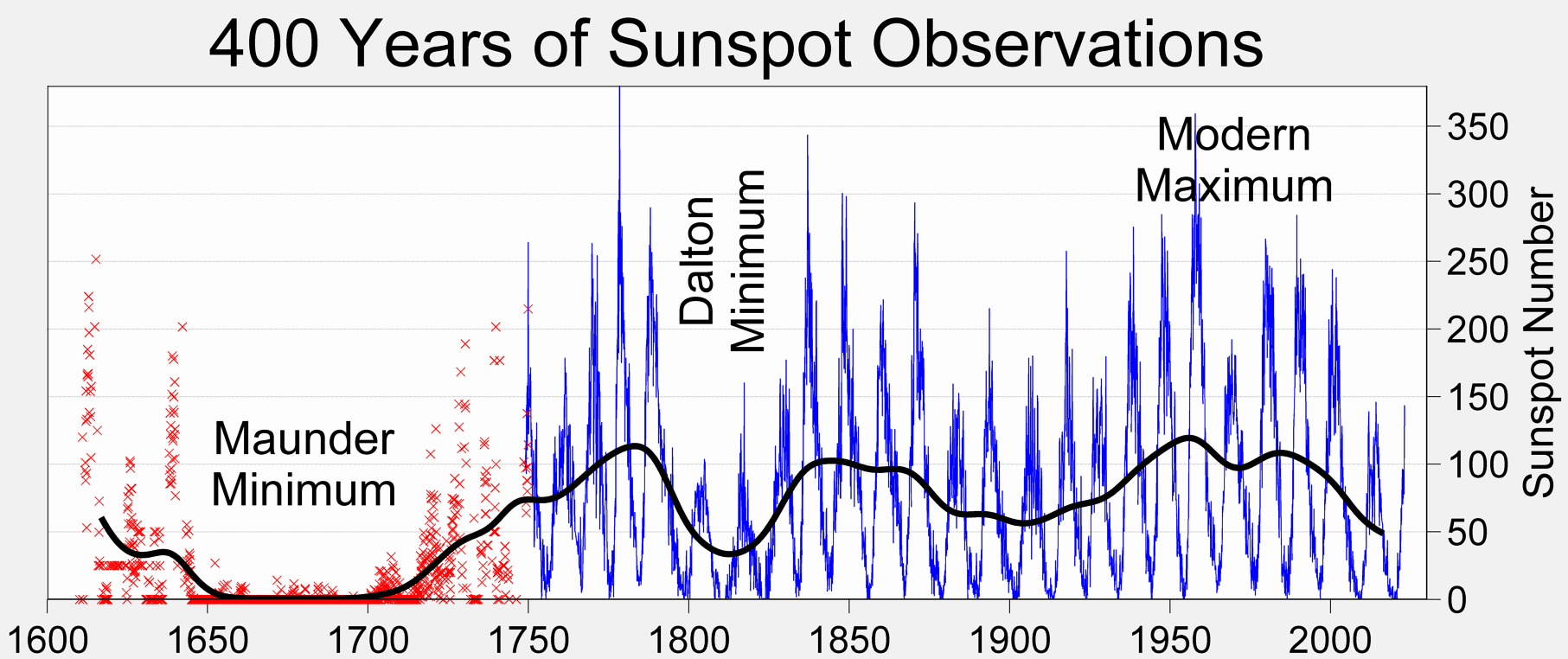During the Maunder Minimum, when solar activity had a 70-year lull, what little activity that did occur operated on a different timeline from the rest of history, Korean astronomical records reveal. The unexpected finding will force a rethink of what was considered a basic feature of solar behavior.
Every 11 years, the Sun produces more sunspots, flares, and coronal mass ejections, leading to increased auroral activity and greater risks of catastrophic geomagnetic storms. The period is not entirely rigid – some peaks have been 9 years apart, others 14, but usually stays close to 11 years.
From 1645-1715, a period known as the Maunder Minimum, however, sunspots largely stopped appearing. It’s only more than 300 years later that we have learned that limited continuing activity operated on an eight-year cycle instead.

Early observations of sunspot numbers are not as accurate as those today, but this chart still reveals how much the Maunder Minimum stood out.
The information comes from Korean records of auroral activity. Auroras are triggered by coronal mass ejections and follow solar activity cycles, which is why they have been so impressive this year. However, Korea is not an obvious place to look. It’s a long way from either of the Earth’s magnetic poles, where auroras are concentrated, particularly during minima.
However, in addition to the more familiar polar aurora, a second type exists, known as red equatorial aurora. These occur in areas where the Earth’s magnetic field is weak enough to allow high energy particles from the Sun to penetrate deep into the atmosphere. The most significant of these is the South Atlantic Anomaly, but unfortunately, this was not well monitored in the 17th Century.
A second area of weakness, called the West Pacific Anomaly (WPA), existed from around 1500 to 1800, neatly including the Maunder Minimum. During the WPA, red aurora were observed from eastern Asia, and fortunately for modern astronomers, the Koreans kept daily records of what they called “vapors like fire light” in their Royal record books.
The number of red auroras depended on the extent of the WPA as well as solar activity, but it seems the WPA danced to a much slower beat than the Sun. In the first half of the Maunder minimum, many aurora were observed. However, instead of following an 11-year pattern, the red auroras peaked every 8.2 years. Scientists who analyzed the observations called this pattern “stable and reliable”.
In contrast, before the Maunder Minimum started, peaks in red aurora activity coincided with what we know of solar activity from other sources.
During the second half of the Maunder Minimum, the red aurora became so sparse a pattern is hard to detect.
Given how vital the Sun is for us, it’s a bit of a worry how poorly we understand solar cycles. The Maunder Minimum represents one of the biggest mysteries – we don’t understand why activity almost ceased for what would normally be six cycles.
Although observations of sunspots date back almost 3,000 years, they’ve only been counted since 1610, soon after Galileo had the idea of turning a telescope to the skies. The existence of solar flares was not recognized until the 19th Century. Two periods with few sunspots had been seen by 1645, so the significance of their long absence was not recognized until much later.
Consequently, detailed records of the small amount of solar activity that did take place during the Maunder Minimum were not kept – no one realized this was something worth tracking.
Some attempts to model what is going on within the Sun during a period of suppressed activity such as the Maunder Minimum show normal 11-year cycles. Others give cycles of different lengths, so the Korean records could help distinguish which models are right.
Several possible explanations for the pattern are tentatively offered in the new research.
The study is open access in AGU Advances.
[H/T: Space.com]
Source Link: Surprising Twist To Solar Cycle Revealed In Korean Records Of Rare Red Aurora